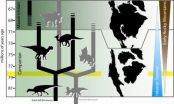(Press-News.org) Durham, NC — A new study of North American songbirds reveals that birds that live with fluctuating weather are more flexible singers.
Mixing it up helps birds ensure that their songs are heard no matter what the habitat, say researchers at Australian National University and the National Evolutionary Synthesis Center.
To test the idea, the researchers analyzed song recordings from more than 400 male birds spanning 44 species of North American songbirds — a data set that included orioles, blackbirds, warblers, sparrows, cardinals, finches, chickadees and thrushes.
They used computer software to convert each sound recording — a medley of whistles, warbles, cheeps, chirps, trills and twitters — into a spectrogram, or sound graph. Like a musical score, the complex pattern of lines and streaks in a spectrogram enable scientists to see and visually analyze each snippet of sound.
For each bird in their data set, they measured song characteristics such as length, highest and lowest notes, number of notes, and the spacing between them.
When they combined this data with temperature and precipitation records and other information such as habitat and latitude, they found a surprising pattern — males that experience more dramatic seasonal swings between wet and dry sing more variable songs.
"They may sing certain notes really low, or really high, or they may adjust the loudness or tempo," said co-author Clinton Francis of the National Evolutionary Synthesis Center.
The Pyrrhuloxia or desert cardinal from the American southwest and northern Mexico and Lawrence's goldfinch from California are two examples.
In addition to variation in weather across the seasons, the researchers also looked at geographic variation and found a similar pattern. Namely, species that experience more extreme differences in precipitation from one location to the next across their range sing more complex tunes. House finches and plumbeous vireos are two examples, Francis said.
Why might this be?
"Precipitation is closely related to how densely vegetated the habitat is," said co-author Iliana Medina of Australian National University. Changing vegetation means changing acoustic conditions.
"Sound transmits differently through different vegetation types," Francis explained. "Often when birds arrive at their breeding grounds in the spring, for example, there are hardly any leaves on the trees. Over the course of just a couple of weeks, the sound transmission changes drastically as the leaves come in."
"Birds that have more flexibility in their songs may be better able to cope with the different acoustic environments they experience throughout the year," Medina added.
A separate team reported similar links between environment and birdsong in mockingbirds in 2009, but this is the first study to show that the pattern holds up across dozens of species.
Interestingly, Francis and Medina found that species with striking color differences between males and females also sing more variable songs, which means that environmental variation isn't the only factor, the researchers say.
### The team's findings were published online in the August 1, 2012 issue of the journal Biology Letters.
CITATION: Medina, I. and C. Francis (2012). "Environmental variability and acoustic signals: a multilevel approach in songbirds." Biology Letters. http://dx.doi.org/10.1098/rsbl.2012.0522
The National Evolutionary Synthesis Center (NESCent) is a nonprofit science center dedicated to cross-disciplinary research in evolution. Funded by the National Science Foundation, NESCent is jointly operated by Duke University, The University of North Carolina at Chapel Hill, and North Carolina State University. For more information about research and training opportunities at NESCent, visit www.nescent.org.
Birds that live with varying weather sing more versatile songs
2012-08-03
ELSE PRESS RELEASES FROM THIS DATE:
Ancient records shed light on Italian earthquakes (Aquila area)
2012-08-03
When a damaging earthquake struck the area of L'Aquila in central Italy in 2009, it was the latest in the region's long history of strong and persistent quakes. The rich recorded history of settlement in the area, along with oral traditions, archaeological excavations, inscriptions and medieval texts, and offer insight into how often the region might expect destructive earthquakes. But according to a new study by Emanuela Guidoboni and colleagues, the historical record on ancient and medieval earthquakes comes with its own shortcomings that must be addressed before the ...
Catching the cap-snatcher
2012-08-03
Researchers at the European Molecular Biology Laboratory (EMBL) in Grenoble, France, have determined the detailed 3-dimensional structure of part of the flu virus' RNA polymerase, an enzyme that is crucial for influenza virus replication. This important finding is published today in PLoS Pathogens. The research was done on the 2009 pandemic influenza strain but it will help scientists to design innovative drugs against all the different influenza strains, and potentially lead to a new class of anti-flu drugs in the next 5-10 years.
The scientists focused on the endonuclease ...
Aerial photos reveal dynamic ice sheet
2012-08-03
Despite the current and rapid melting of the Greenland Ice Sheet, it remains far from certain just when we will have reached a point when scientists will be able to predict its disappearance. Recent research conducted by the University of Copenhagen in conjunction with the Technical University of Denmark (DTU) and the Danish National Survey and Cadastre (KMS) in collaboration with an international team of scientists reports that this is not the first time in recent history that the ice sheet has been in retreat and then stabilised again. The researchers' results have just ...
Alzheimer's cognitive decline slows in advanced age
2012-08-03
The greatest risk factor for Alzheimer's disease (AD) is advancing age. By age 85, the likelihood of developing the dreaded neurological disorder is roughly 50 percent. But researchers at the University of California, San Diego School of Medicine say AD hits hardest among the "younger elderly" – people in their 60s and 70s – who show faster rates of brain tissue loss and cognitive decline than AD patients 80 years and older.
The findings, reported online in the August 2, 2012 issue of the journal PLOS One, have profound implications for both diagnosing AD – which currently ...
Plant-based compound slows breast cancer in a mouse model
2012-08-03
The natural plant compound phenethyl isothiocyanate (PEITC) hinders the development of mammary tumors in a mouse model with similarities to human breast cancer progression, according to a study published August 2 in the Journal of the National Cancer Institute.
Edible plants are gaining ground as chemopreventative agents. PEITC has shown to be effective as a chemopreventative agent in mice for colon, intestinal, and prostate cancer, by inducing apoptosis.
In order to determine the efficacy of PEITC in mammary tumors in mice, Shivendra V. Singh, Ph.D., of the University ...
Cuckoo tricks to beat the neighborhood watch
2012-08-03
To minimise the chance of being recognised and thus attacked by the birds they are trying to parasitize, female cuckoos have evolved different guises. The new research, funded by the Natural Environment Research Council, was published today, 03 August, in the journal Science.
The common cuckoo (Cuculus canorus) lays its eggs in the nests of other birds. On hatching, the young cuckoo ejects the host's eggs and chicks from the nest, so the hosts end up raising a cuckoo chick rather than a brood of their own. To fight back, reed warblers (a common host across Europe) have ...
Breast cancer charity under fire for overstating the benefits of screening
2012-08-03
Professors Lisa Schwartz and Steven Woloshin of the Center for Medicine and the Media at The Dartmouth Institute for Health Policy and Clinical Practice argue that last year's breast cancer awareness month campaign by Susan G Komen for the Cure "overstates the benefit of mammography and ignores harms altogether."
Their views are published on bmj.com today as part of an occasional series highlighting the exaggerations, distortions, and selective reporting that make some news stories, advertising, and medical journal articles "not so."
A growing and increasingly accepted ...
5-year survey confirms Uruguay's world-leading tobacco control strategy is delivering results
2012-08-03
Implementation of graphic labels at 80% of the pack size front and back led to increased awareness of the risks of smoking
Ban on multiple brand presentations reduced smokers' false beliefs that some cigarettes (e.g., "light" or "mild" cigarettes) are less harmful
Strong support for tobacco control policies among smokers
(Thursday August 2nd, 2012, Montevideo, Uruguay and Waterloo, Ontario, Canada): The International Tobacco Control Policy Evaluation Project (the ITC Project) today launched a new report on the effectiveness of tobacco control policies in Uruguay. ...
Mountains, seaway triggered North American dinosaur surge
2012-08-03
ATHENS, Ohio (Aug. 2, 2012)—The rise of the Rocky Mountains and the appearance of a major seaway that divided North America may have boosted the evolution of new dinosaur species, according to a new Ohio University-led study.
The finding, published today in the journal PLOS ONE, may explain patterns of evolution and migration of North American duck-billed and horned dinosaurs in the years leading up to their extinction 65 million years ago, said Terry Gates, a postdoctoral researcher with Ohio University's Heritage College of Osteopathic Medicine who is lead author on ...
Close to the bone
2012-08-03
A genetic screening approach to studying bone disease has found nine new genes associated with bone health and suggests a new way to discover genes that may be implicated in human skeletal diseases. A collaborative study of the mineral content, strength and flexibility of bones has found clues to the cause of bone disorders such as osteoporosis, osteogenesis imperfecta, and high bone density syndromes. The study, which brings together specialist skills in mouse gene deletion and bone measurement to assess the strength of bones in 100 mutant mouse lines, is the largest ...

